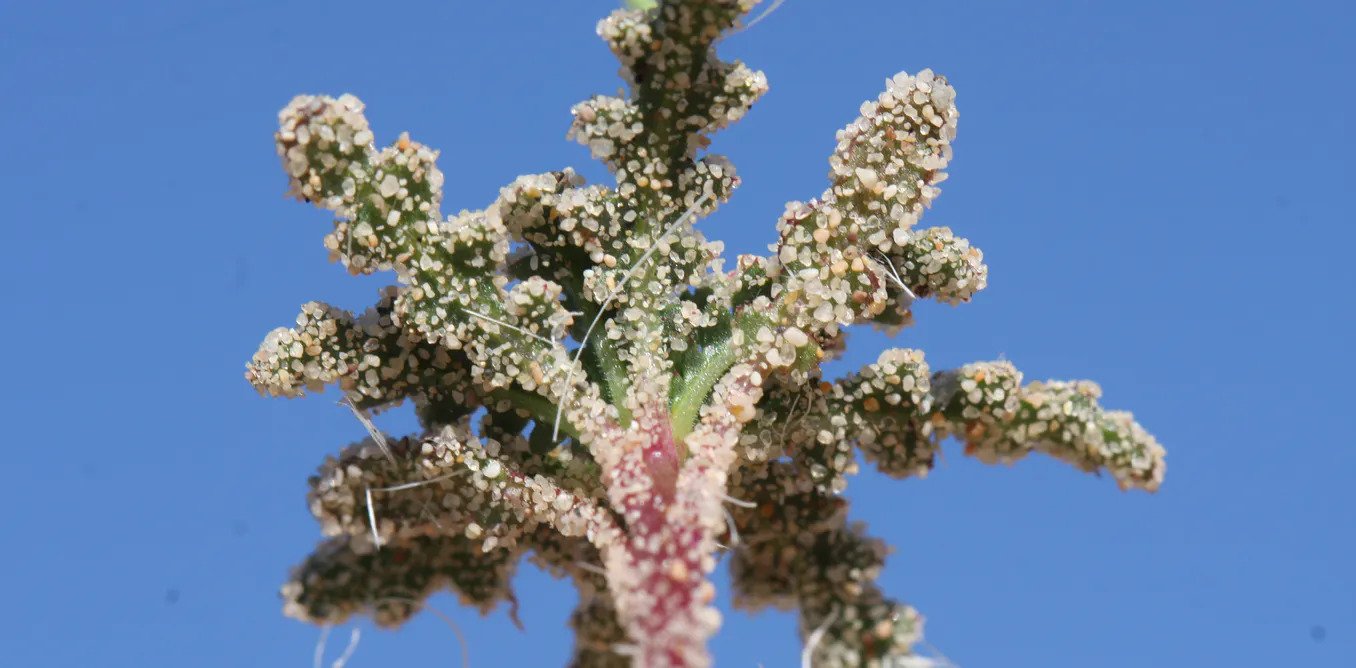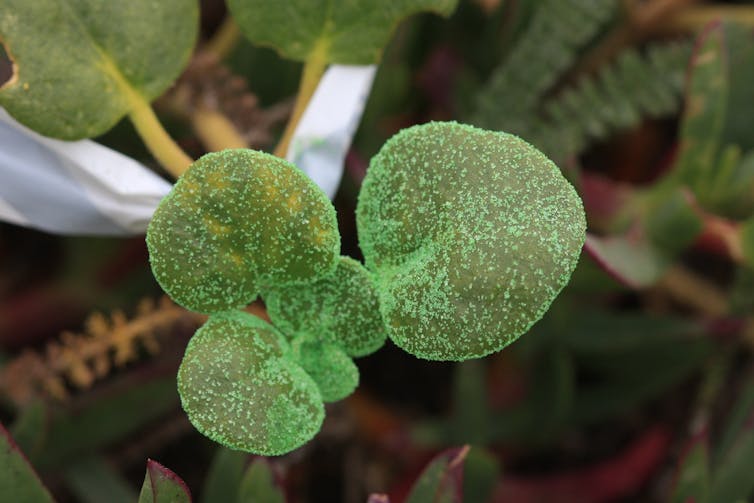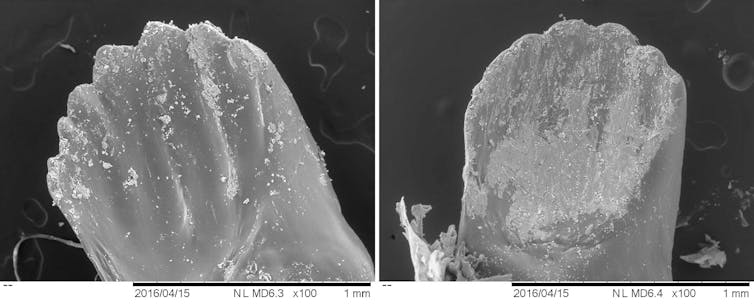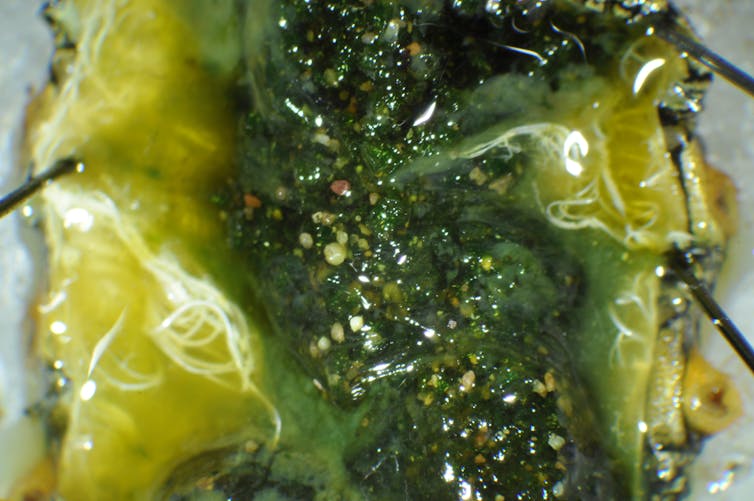 A coat of sand makes an effective armor. Eric LoPresti, CC BY-SA
A coat of sand makes an effective armor. Eric LoPresti, CC BY-SA
–
![]() Author: Assistant Professor of Plant Biology, Ecology and Evolution, Oklahoma State University
Author: Assistant Professor of Plant Biology, Ecology and Evolution, Oklahoma State University
2021 Jan 20
–
Imagine the texture of a plant. Many may come to mind – the smooth rubberiness of many tropical houseplants, the impossibly soft lamb’s ear, the sharp spines of cacti, or the roughness of tree bark. But stickiness, in the flypaper-stick-to-your-fingers sense, probably isn’t at the top of your list.
Nevertheless, a great many plants have evolved sticky leaves, stems and seeds, including some you likely know – such as petunias and tobacco.
In evolutionary biology, a trait that has evolved many times is interesting, since it suggests that over and over this trait serves some benefit. While people have noticed and discussed this odd characteristic for a great many years, biologists like me are finally beginning to understand what stickiness is for – and why so many plants have it.
Sand and stickiness
Sticky plants are widespread. They are found in temperate and tropical areas, in wet and dry places and in forests, fields and dunes. In each of these environments, stickiness functions somewhat differently.
I am naturally drawn to sand dunes, whether in dry deserts or along beautiful coastlines, and stickiness has some interesting functions for plants in these locations. Shifting sand presents a challenging environment for plants – sand-blasting winds, potential burial and the lack of water retention are just a few.
Interestingly, hundreds of plant species in sand dunes have evolved sticky surfaces, suggesting utility in that habitat. Windblown sand coats these sticky surfaces – a phenomenon known as psammophory, which means “sand-carrying” in Greek. While a sandy coating may limit light from reaching plant surfaces, it also likely protects plants from abrasion and reflects light, reducing leaf temperature. It also defends plants from hungry predators.
A few years ago, my colleagues and I studied yellow sand verbena (Abronia latifolia) plants in coastal California. When we gently removed sand from leaves and stems, those leaves and stems got eaten by hungry snails, caterpillars and other herbivorous animals at twice the rate of sand-intact leaves and stems.

–
We wondered if the sand might be protecting plants by camouflaging them. With a second experiment, we carefully cleaned and re-coated some verbena leaves with tinted sand that didn’t match the background. It turned out the color of the sand didn’t matter – predators ate the sand-covered leaves at the same rate, regardless of whether they blended with their background or not – showing sand protects plants as a physical barrier, rather than as a camouflage.
Wearing down mouthparts
This result makes intuitive sense – after all, who wants to eat something covered in sand, even if it is nutritious? Yet I’ve observed over the years that a great many herbivorous insects do indeed eat sandy leaves. It got me wondering what effect the sand might be having on them, so we did a series of simple experiments.

–
When we gave caterpillars a choice between eating sand-free and sand-covered plants, they overwhelmingly chose to eat sand-free plants. When we gave caterpillars no choice – one group getting only sandy leaves, the other getting clean leaves – we observed the mandibles, or mouthparts, of the sand eaters were noticeably worn down.

–
The sand-eating caterpillars also grew about 10% more slowly than those fed on nonsandy foliage, we suspect in part because they were ingesting some sand.
Sticky seeds
In sandy areas, it’s also common to find seeds that become sticky when moistened. Such seeds are coated in mucilage, which are simple carbohydrates that, in the presence of water, become a sticky mess. Even when they dry out, they can become sticky again, virtually indefinitely. You may be familiar with this phenomenon in chia seeds – mucilage is what gives chia pudding its distinctive texture.
When a mucilage-coated seed falls into sand, gets moistened by rainfall or dew and then dries, it becomes encrusted in a heavy coating of sand. This extra weight makes it difficult for carpenter ants to carry the seeds back to their nests to consume.

–
We demonstrated this by making feeding stations where we could measure removal rates of sand-covered seeds and bare seeds. In nearly all of the 53 plant species we tested, the sandy seeds were removed far more slowly than the bare seeds.
While plant stickiness in sandy areas creates a barrier to stop herbivores, in other habitats it operates differently. For example, some carnivorous plants use stickiness to catch prey.
Every bit of a plant is shaped, over millions of years, by having to confront the challenges of the world around it while remaining rooted in a single place. Stickiness is one of thousands of strategies plants have stumbled on to survive the onslaught of hungry animals in nature.
–
[Understand new developments in science, health and technology, each week. Subscribe to The Conversation’s science newsletter.]
–
–
Want to write?
Write an article and join a growing community of more than 119,800 academics and researchers from 3,852 institutions.









